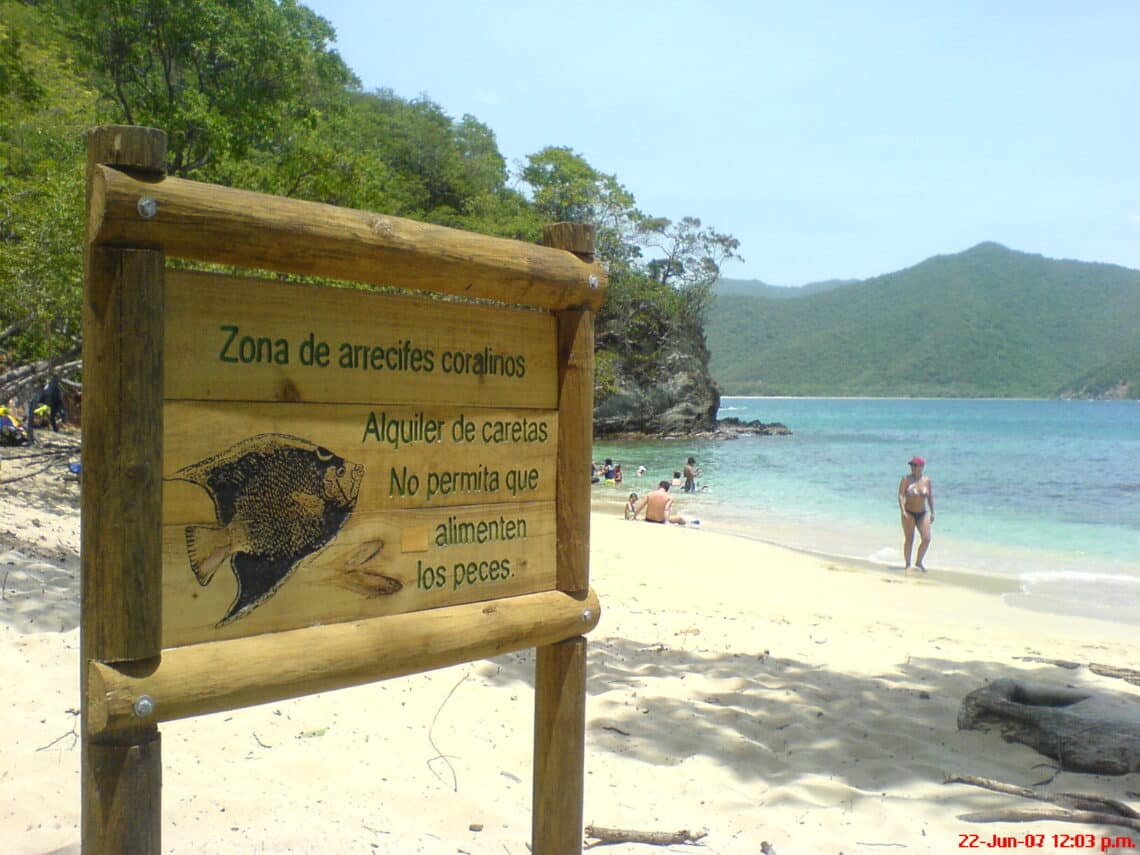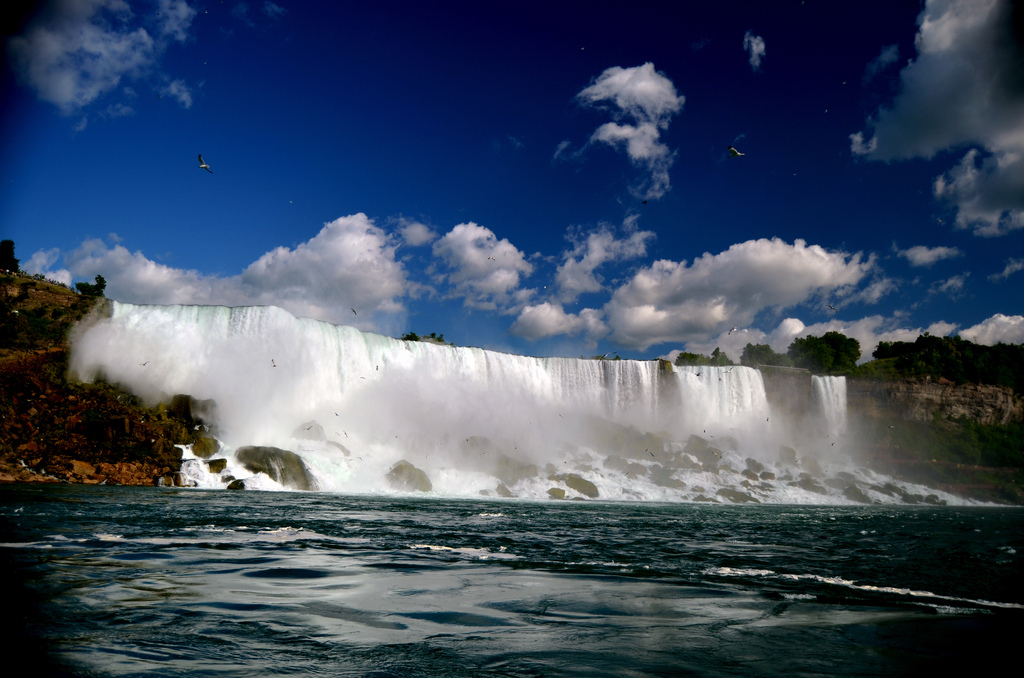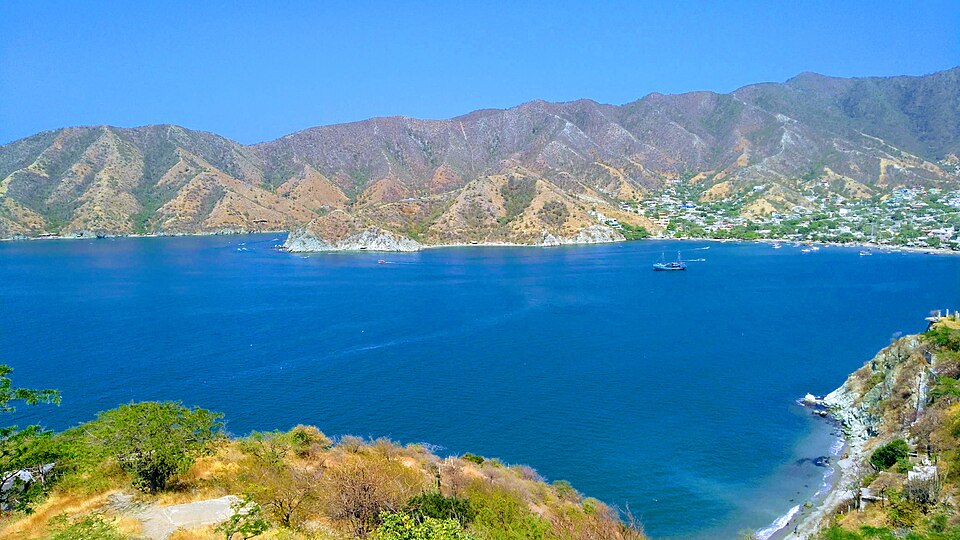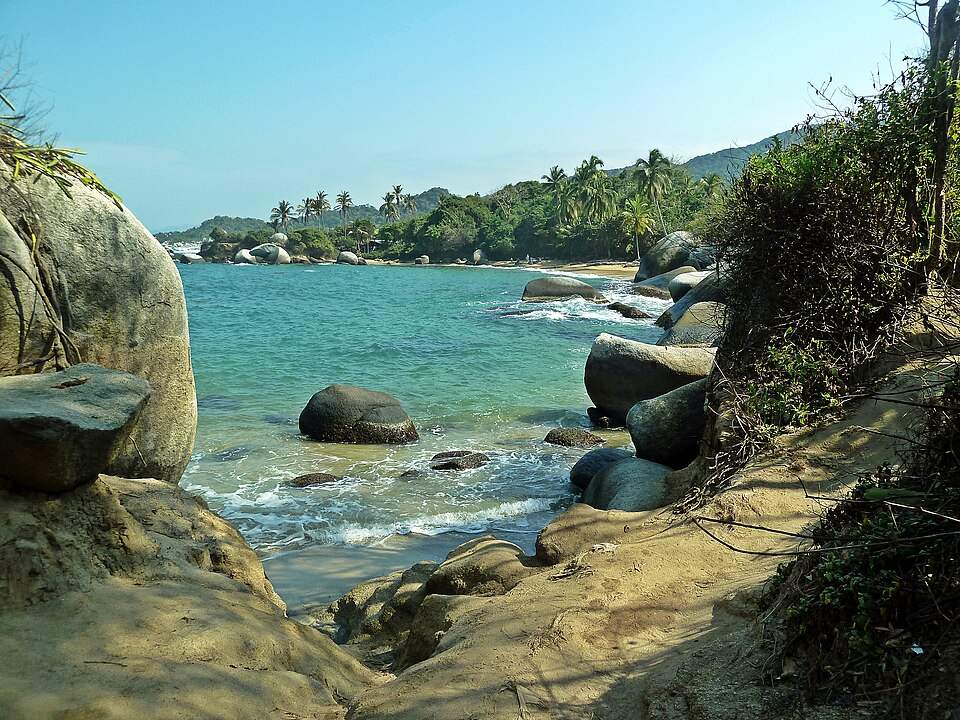
Playa Cristal Santa Marta: How to Visit This Hidden Caribbean Paradise (+ Is It Worth It?)
What Makes Playa Cristal Special
Playa Cristal sits within Tayrona National Park boundaries, specifically in the Neguanje sector. The beach curves gently in a protected cove backed by verdant hills that rise dramatically from the shoreline. It’s that specific combination—Caribbean blue water, lush green mountains, coral reefs close to shore—that creates Playa Cristal’s signature look.
The name “Crystal Beach” comes from the water clarity, which can be genuinely impressive when conditions align. On calm days with good visibility, you can see straight down to the sandy bottom and watch fish swimming around coral formations. The protected cove location means the water tends to be calmer here than at many other Tayrona beaches, making it one of the better swimming spots in the park.
Perhaps more importantly, the 300-person daily limit actually works. Unlike some beaches in Colombia that claim capacity restrictions but don’t enforce them, Playa Cristal genuinely caps visitors. This means even during high season, you’re not fighting for beach space or swimming through crowds of people. The relatively controlled access preserves that pristine feeling that’s increasingly rare on Caribbean beaches.
What Playa Cristal isn’t, though, is some untouched desert island. There are vendors, a restaurant, bathroom facilities, and enough infrastructure to support daily tour groups. It’s protected and beautiful, yes, but not remote in the castaway sense. For a complete overview of all beach options in the area, including more secluded alternatives, check our guide to Santa Marta Colombia beaches.
How to Get to Playa Cristal
This is where things get interesting, because your route to Playa Cristal significantly affects your overall experience. You’ve got three main options, each with distinct advantages and drawbacks.
Option 1: Direct Boat from Santa Marta or El Rodadero
The most straightforward option departs from Santa Marta’s marina or El Rodadero’s north pier. You board a boat that takes you directly to Playa Cristal via open Caribbean waters, typically making scenic passes by other bays and beaches along the way.
Cost: 150,000-170,000 COP ($38-$43 USD) for most tours, which usually includes park entrance, insurance, and sometimes lunch.
Duration: About 1 hour each way on the water, though departure times can be flexible depending on the tour operator.
Pros: Simple logistics with no transfers, direct route saves time, typically includes guided elements, and you get panoramic coastal views during the journey.
Cons: Here’s the thing nobody likes to advertise—the open-water portion can be genuinely rough. We’re talking waves that soak everyone onboard, enough rocking that sensitive stomachs struggle, and conditions that can feel borderline unsafe when the Caribbean is particularly choppy. Multiple reviews mention this specifically, with some travelers rating it as the worst part of their trip.
If you choose this route, bring a waterproof bag for everything you don’t want drenched. Your phone, wallet, extra clothes—seal them up. Sit toward the middle of the boat where motion is less extreme, and maybe skip breakfast if you’re prone to seasickness. The operators will provide life jackets, though quality varies considerably between tour companies.
Tours typically depart around 9:00-9:30 AM and return between 3:00-4:00 PM, giving you roughly 4-5 hours at the beach itself. Departure times can slide though, so don’t plan anything time-sensitive for later that day.
Option 2: Land Route via Neguanje
This option involves significantly more steps but avoids the rough open-water crossing that makes some visitors genuinely nervous. Here’s how it works:
Take transportation from Santa Marta along the Troncal del Caribe highway toward La Guajira. You’ll turn off at the Neguanje entrance (look for it just before the toll booth, less than 1 kilometer away). From there, take the unpaved road to Neguanje Beach—this takes about 20-30 minutes and can be rough, especially during rainy season.
At Neguanje, you have two choices to reach Playa Cristal:
- Short boat ride: 20,000-25,000 COP per person for an 8-10 minute boat trip in calm, protected waters. This is nothing like the open-water journey—it’s smooth, scenic, and comfortable.
- Hiking: About 40 minutes walking along a coastal trail. The path offers beautiful views and gets you there without spending extra money, though you’ll arrive hotter and sweatier.
Total Cost: Varies depending on transportation choices, but figure around 100,000-120,000 COP if you’re arranging everything independently, plus park entrance fees (73,500-92,000 COP for foreigners).
Pros: You avoid the rough open-water crossing, have more flexibility in timing, can spend as much or little time as you want at Playa Cristal, and potentially save some money. The route also lets you visit Neguanje beach itself, which is lovely and way less crowded.
Cons: More complicated logistics requiring multiple transfers, the unpaved road section can be uncomfortable, and you need to coordinate several elements yourself rather than following a tour guide.
This route works particularly well if you’re traveling with others and can split taxi costs, or if you’re renting a car during your Santa Marta stay. The unpaved section isn’t terrible with a decent vehicle, just bumpy. Drive carefully and take your time, especially after any recent rain.
Option 3: Budget Route via Taganga
The cheapest option starts in Taganga, the small fishing village about 10 minutes from Santa Marta’s center. Take a local bus from Santa Marta to Taganga (around 2,000-3,000 COP), then catch a boat from Taganga’s beach directly to Playa Cristal.
Cost: Boats from Taganga to Playa Cristal cost around 100,000-120,000 COP per person for a round-trip. You’ll pay park entrance and insurance separately.
Duration: The boat ride itself takes about 30-40 minutes. Total travel time including the bus to Taganga runs close to an hour each way.
Pros: Cheaper than direct tours from Santa Marta, especially if you’re watching your budget closely. Taganga has a nice beach vibe, so starting your day there isn’t unpleasant.
Cons: Still involves open-water sections that can be rough, requires the extra step of getting to Taganga first, and departure times tend to be less structured than organized tours.
Many budget travelers and backpackers choose this route. If you’re staying in Taganga anyway (it’s popular for cheap hostels and diving courses), this becomes the obvious choice. For more information about Taganga and where to stay, our where to stay in Santa Marta guide covers different neighborhood options including Taganga’s backpacker scene.
My Recommendation
If you’re not particularly budget-constrained and want simplicity, the direct boat from Santa Marta works fine despite the rough waters—just prepare mentally and physically for a bumpy ride. If you have any concerns about boat safety or seasickness, or if you value flexibility, the land route through Neguanje makes more sense. It’s more steps, sure, but each individual step feels safer and more controlled.
The Taganga route splits the difference, offering savings without quite as much logistical complexity as the Neguanje option. There’s no definitively “best” choice—it depends on your priorities around budget, comfort, and adventure tolerance.
Park Entrance Fees and Requirements
Playa Cristal sits within Tayrona National Park, which means park entrance fees apply. These vary by season and residency status:
High Season (December-January, June-July, Holy Week, long weekends):
- Foreign tourists: 87,000-92,000 COP (approximately $22-$23 USD)
- Colombian residents: 27,500-41,000 COP depending on age
Low Season (all other dates):
- Foreign tourists: 73,500-77,500 COP (approximately $18-$19 USD)
- Colombian residents: 24,500-35,000 COP depending on age
Mandatory Insurance: 6,000-7,000 COP (cash only, covers accident and rescue services)
Most organized tours include these fees in their package price, but always confirm what’s covered before booking. If you’re going independently via Neguanje, you’ll pay these fees at the entrance checkpoint along with the insurance charge.
You’ll need your physical passport—photocopies don’t work. They’ll give you a wristband with entry date that you need to wear during your visit. Technically these wristbands are valid for multiple days if you’re camping elsewhere in Tayrona, though Playa Cristal itself doesn’t have overnight facilities.
For complete information about Tayrona National Park including other beaches you can visit with the same entrance ticket, see our comprehensive Tayrona National Park beaches guide.
Snorkeling at
Let’s talk about what you’re probably most interested in—the underwater experience. Snorkeling is the main activity at Playa Cristal, and it’s genuinely the beach’s strongest selling point.
What You’ll See
The coral reef sections near Playa Cristal host a solid variety of tropical Caribbean fish. Expect to encounter parrotfish, angelfish, sergeant majors, and various smaller species in pretty good numbers. The corals themselves include both hard and soft varieties, creating that colorful underwater landscape that makes snorkeling worthwhile.
Schools of fish often swim quite close, sometimes surrounding snorkelers in those magical moments that make for great underwater photos. Sea turtles do visit this area, though sightings are somewhat rare and depend heavily on timing and luck. If you do spot one, maintain respectful distance and let it go about its business.
The reef isn’t massive—we’re not talking Belize or the Maldives here. But for Colombia’s Caribbean coast, it’s quite good. The combination of reef accessibility (close to shore, relatively shallow) and decent fish populations creates a satisfying snorkeling experience for both beginners and more experienced snorkelers.
Water clarity varies significantly based on recent weather, wave action, and season. On excellent days, visibility reaches 15-20 meters. After storms or during rougher periods, visibility drops considerably with stirred-up sediment clouding the water. This is why some visitors rave about crystal-clear conditions while others report disappointing murkiness—timing matters.
Equipment and Logistics
Here’s something important: since the pandemic, many operators stopped renting full snorkel sets and now only provide masks. You might get just a mask without the snorkel tube, which makes the underwater experience significantly less enjoyable. Some tours do still provide complete sets, but you should confirm this when booking.
If you’re serious about snorkeling, consider bringing your own equipment or at minimum your own snorkel and mask. Good-quality gear that fits properly makes a huge difference, and you won’t be wondering where 50 other mouths have been before yours touched that rental snorkel.
The snorkeling zone is marked off, and guides typically lead groups around the reef areas pointing out interesting sights. You can also explore independently if you’re a confident swimmer, though staying within the designated areas is both required and smart—the currents beyond the protected cove can be strong.
For a detailed breakdown of all the best snorkeling spots around Santa Marta including comparisons between different locations, check our complete guide to snorkeling in Santa Marta.
Safety Considerations
While Playa Cristal is generally safe for swimming and snorkeling, a few cautions apply. The water gets deep relatively quickly—this isn’t a gradual shallow slope. If you’re not a strong swimmer, stay closer to shore and definitely wear a life jacket.
Currents can pick up, especially at the edges of the cove or during rougher weather. If you feel yourself being pulled in a direction you don’t want to go, don’t fight it directly. Swim perpendicular to the current until you escape its pull, then head back to shore at an angle.
The coral looks touchable but isn’t. Beyond the ecological damage touching causes, many corals sting or have sharp edges that can cut skin. Look with your eyes, photograph with your camera, but keep your hands to yourself.
Some vendors apparently feed fish with crackers to create those photo-worthy swarms around tourists. This isn’t great for the fish or the reef ecosystem, despite making for impressive Instagram content. You can enjoy the natural fish behavior without needing artificial feeding to enhance the experience.
Beach Facilities and Amenities
What’s Available
Playa Cristal has more infrastructure than you might expect for a beach within a national park. There’s a restaurant serving lunch throughout the day—typically fish, chicken, rice, salad, and basic Colombian plates. The food is decent though not exceptional, with prices running higher than outside the park (expect 25,000-40,000 COP for a meal).
Bathroom facilities exist, though they’re basic. We’re talking standard park bathrooms—functional but not fancy. There are cold-water showers for rinsing off salt and sand, which feels pretty amazing after hours in the sun.
Beach chairs and tents (shade structures) are available for rent, though many areas have natural shade from trees. Getting there early gives you better choice of shaded spots. The sand itself isn’t pure white as some marketing photos suggest—it’s more of a light tan, still pleasant but don’t expect powdery Caribbean white sand.
Vendors sell drinks, snacks, and fresh fruit throughout the day. Prices are tourist-focused but not outrageously so. Bring cash because card payment is either unavailable or unreliable depending on the vendor.
What to Bring
Pack strategically for Playa Cristal. Here’s what actually matters:
- Waterproof bag or dry bag: Essential for protecting electronics and valuables, especially if you’re taking the boat route.
- Reef-safe sunscreen: Regular sunscreen damages coral reefs. Use mineral-based sunscreen with zinc oxide or titanium dioxide.
- Your own snorkel gear: If you’re particular about equipment or want guaranteed full set.
- Underwater camera or housing: The snorkeling is worth documenting.
- Cash: No ATMs, cards are unreliable.
- Light towel: Quick-dry type if possible.
- Hat and sunglasses: The sun is intense.
- Water bottle: Stay hydrated.
- Snacks: If you’re picky about food or get hangry.
What you can leave behind: expensive jewelry, extra valuables, too many electronics, heavy cameras that you won’t want to deal with on the beach. While theft isn’t rampant, it does occasionally happen, and there’s no reason to tempt fate.
The 300-Person Daily Limit
Playa Cristal’s visitor cap gets mentioned frequently, but how does it actually work in practice? The beach officially allows around 300-350 people per day (sources vary slightly on the exact number). This limit is genuinely enforced through the entrance wristband system.
During high season—particularly December-January and Holy Week—the limit can be reached, especially on weekends. Tours book up weeks in advance during peak periods. If you’re traveling during these times, reserve your tour or arrange your visit at least 2-3 weeks ahead.
During low season and midweek, the beach rarely hits capacity. You’ll see fewer people, have more beach space, and encounter a more relaxed vibe. The trade-off is potentially less predictable weather, but for many visitors, that’s worth it for the smaller crowds.
The limit keeps the beach from feeling overcrowded, but “uncrowded” is relative. Three hundred people on a beach is still three hundred people. It’s not going to feel like a private paradise, just less packed than beaches without limits would be. Manage your expectations accordingly.
Best Time to Visit Playa Cristal
Season and Weather
The driest months—December through March—offer the most reliable weather with calm seas and better water clarity for snorkeling. This is prime time, which is exactly why it’s also the most crowded and expensive period.
July and August provide another dry window with decent conditions, though not quite as consistently perfect as the December-March period. These months see good visitor numbers but not quite the same intensity as peak high season.
April-May and September-November bring more rainfall. This doesn’t make visits impossible, but rough seas become more likely, affecting both boat travel and snorkeling visibility. Some days will be perfect; others will be washouts. If you’re visiting during these months, build flexibility into your plans.
The park closes for environmental recovery periods, typically in February and again around October-November. Exact closure dates vary annually, so check the official Tayrona National Park website before finalizing plans. Showing up to a closed park ranks among the most frustrating travel experiences.
Time of Day
Morning visits tend to offer calmer waters and better snorkeling conditions. The earlier boats (departing around 8:00-9:00 AM) get you to the beach while conditions are typically at their best. By afternoon, winds often pick up and water clarity can decrease.
Early arrival also means better shade spot selection and less crowded beach time. Most tours spend roughly 4-5 hours at the beach, with midday being the busiest period when multiple tours overlap.
Weekday vs. Weekend
Weekdays see fewer Colombian visitors, making for a generally more peaceful experience. Long weekends and holidays bring bigger crowds, with the beach sometimes reaching its capacity limit. If your schedule allows flexibility, aim for Tuesday-Thursday visits.
Is Playa Cristal Worth It? The Honest Assessment
Time for straight talk. Whether Playa Cristal is “worth it” depends entirely on what you’re comparing it to and what you value in a beach experience.
Reasons to Visit
- Excellent snorkeling for Colombia: The reef and fish populations genuinely deliver, making this one of the better snorkeling spots accessible from Santa Marta.
- Stunning mountain backdrop: The scenery is legitimately beautiful, with those dramatic green hills rising right from the beach.
- Controlled crowds: The visitor limit actually works, preventing the overwhelming crowds that plague many Caribbean beaches.
- Protected swimming: The cove location creates safer swimming conditions than many other Tayrona beaches.
- Complete day experience: With organized tours, everything is handled—transportation, entrance fees, usually lunch—making logistics simple.
Reasons to Reconsider
- Boat ride challenges: The potentially rough open-water crossing genuinely bothers many visitors, with some rating it the worst part of their trip.
- Overhyped expectations: If you arrive expecting the most spectacular beach of your life, you’ll probably leave disappointed.
- Not actually white sand: Despite marketing photos, the sand is regular beach tan, not Caribbean white.
- Higher costs: Between tour prices and on-beach expenses, Playa Cristal costs more than many alternatives.
- Variable conditions: Water clarity and calmness fluctuate significantly based on recent weather, meaning your experience might differ substantially from others’ reviews.
Who Should Visit
Playa Cristal makes most sense for visitors who genuinely enjoy snorkeling and want to explore underwater environments. If you’re primarily interested in beach lounging and sunbathing, other beaches might serve you better for less effort and expense.
Photographers will appreciate the scenic backdrop, especially that distinctive mountain-meets-ocean view. The setting is legitimately photogenic, even if the beach itself doesn’t quite live up to some of the heavily edited Instagram images.
First-time visitors to Santa Marta who want to experience Tayrona National Park but can’t commit to the full hiking experience will find Playa Cristal a good compromise—you get that national park setting without the 2-hour trek.
Who Might Skip It
If you’re prone to seasickness or genuinely nervous about boat travel, the stress of the journey might outweigh the beach experience. The land route via Neguanje exists as an alternative, but it adds complexity that some travelers prefer to avoid.
Visitors with limited budgets might find better value at other Santa Marta beaches that offer easier access and lower costs. El Rodadero, for instance, provides family-friendly beach time without the expense or logistical challenges. Our El Rodadero beach guide covers this more accessible alternative.
If you’ve been to world-class Caribbean beaches elsewhere, Playa Cristal might feel underwhelming. It’s lovely by Colombian Caribbean standards but doesn’t compete with the Bahamas, Belize, or the Mexican Caribbean’s best spots.
Alternatives to Consider
If you’re on the fence about Playa Cristal, several alternative beaches around Santa Marta offer different experiences that might better match your preferences.
Cabo San Juan in Tayrona National Park provides that quintessential jungle-meets-beach experience with the option to camp overnight. It requires hiking but rewards visitors with iconic scenery and better overall atmosphere. Check our Tayrona National Park beaches guide for complete details.
Bahía Concha offers calmer, more family-friendly conditions with easier access and lower entrance fees. It lacks Playa Cristal’s snorkeling but provides spacious beach area and good swimming.
La Piscina beach in Tayrona gets its nickname from naturally protected, pool-like conditions perfect for swimming and snorkeling without the boat journey. It requires the Tayrona hike but avoids the separate boat logistics.
Multiple beaches can be combined on boat tours that visit several spots in one day. These tours offer variety and help you compare different beaches rather than putting all your expectations on Playa Cristal alone. Our Santa Marta boat tours guide covers various multi-beach tour options.
Practical Tips from Experience
A few hard-won lessons that might save you some frustration:
Book tours in advance during high season. Last-minute bookings often mean either no availability or getting stuck with less reputable operators who cut corners on safety or service quality.
Bring Dramamine or ginger candies if you’re even slightly susceptible to motion sickness. The boat ride can be genuinely rough, and being seasick ruins the entire experience.
Arrive with adjusted expectations. Think of Playa Cristal as a very good Colombian Caribbean beach with excellent snorkeling, not as the most spectacular beach in the universe. This mental calibration prevents disappointment.
Order lunch early if you’re eating at the beach restaurant. Food preparation takes time, and you don’t want to waste an hour of your limited beach time waiting for plates to arrive.
Protect your belongings but don’t be paranoid. Theft happens occasionally but isn’t rampant. Use common sense—don’t leave valuables unattended, keep cash with you, seal electronics in waterproof bags.
Respect marine life and coral. Look, photograph, enjoy, but don’t touch. You’ll help preserve the ecosystem that makes the beach special while avoiding potential stings or cuts.
Have a backup plan. If weather looks rough or you feel nervous about boat conditions, it’s okay to reschedule or choose an alternative beach. No beach is worth genuinely unsafe travel conditions.
Combining Playa Cristal with Other Attractions
Playa Cristal works well as part of a larger Santa Marta beach exploration rather than your sole beach visit. The region offers incredible variety, and experiencing multiple beaches helps you appreciate each one’s unique character.
Consider pairing Playa Cristal’s snorkeling-focused experience with Cabo San Juan’s camping adventure for a well-rounded Tayrona experience. Or balance it with easier-access beaches like El Rodadero or Bahía Concha that serve different purposes—family time, sunset watching, or simply relaxing without logistical challenges.
Multi-day Santa Marta itineraries might include Playa Cristal as one element among several, mixing challenging adventures with easier days, snorkeling spots with pure lounging beaches, and touristy areas with quieter escapes. For help planning the complete beach experience, our comprehensive Santa Marta beaches guide covers all your options with honest comparisons.
Final Verdict
So, is Playa Cristal worth visiting? For most people interested in snorkeling and willing to handle some logistical complexity, yes. The combination of decent reef snorkeling, beautiful scenery, and controlled crowds creates a solid beach experience that represents Colombia’s Caribbean coast well.
Just go in with realistic expectations. It’s a very good beach with excellent snorkeling for the region—not a transcendent, life-changing, most-perfect-beach-ever destination. The journey requires either tolerance for rough boat rides or willingness to navigate the more complex land route. The costs run higher than simpler beach options.
But there’s something genuinely special about swimming in that protected cove with tropical fish gliding beneath you and green mountains rising above. When conditions align—calm waters, good visibility, perfect Caribbean sunshine—Playa Cristal delivers moments that justify the hype. When conditions don’t align, it’s still a pleasant beach day, just not the magical experience some reviews promise.
Perhaps that’s the key insight: Playa Cristal is worth visiting once to see for yourself, but whether it becomes a beloved favorite or a “nice but overrated” memory depends on factors partly beyond your control—weather, timing, and that mysterious alchemy that makes some beaches speak to you while others don’t.
Go, snorkel, enjoy the scenery, take your photos. Then decide for yourself whether Playa Cristal earned its reputation or merely borrowed it from clever marketing and well-timed Instagram shots. Either way, you’ll have experienced one of Tayrona’s most famous beaches and can form your own opinion rather than relying on conflicting reviews online.
That, ultimately, is worth the boat ride—rough waters and all.
You May Also Like

Top Things To Do and Where to Stay on Your Ultimate Bro Getaway in San Diego
January 10, 2017
When is the Best time to Visit Canada?
January 20, 2016





